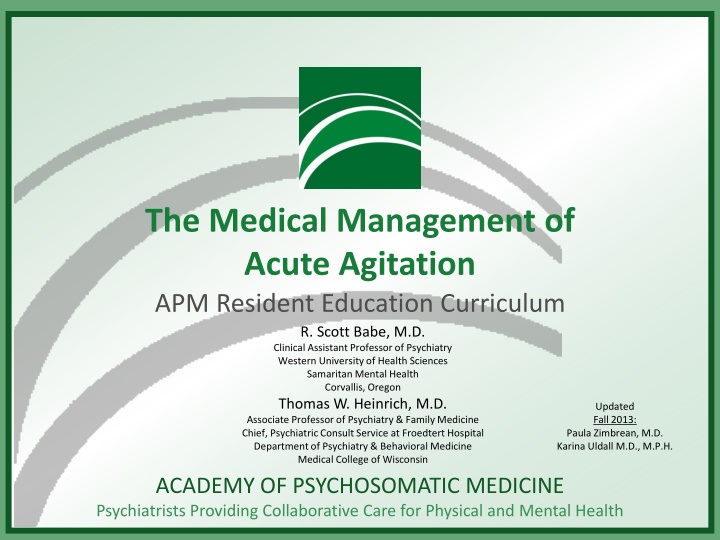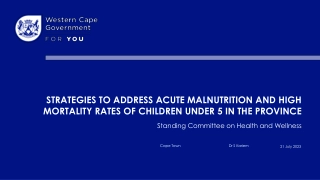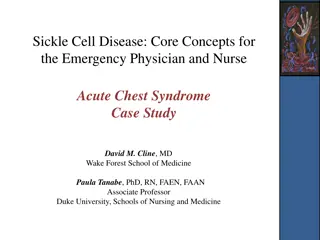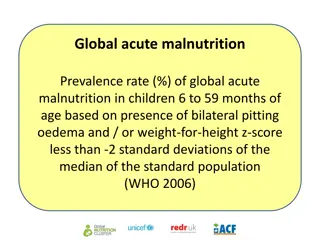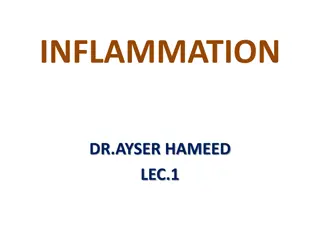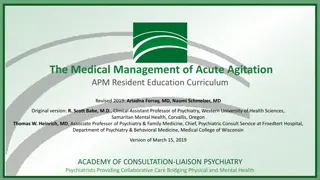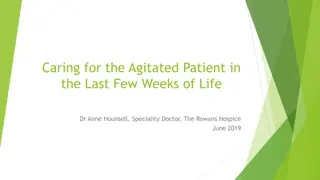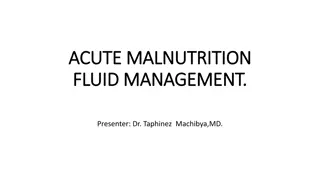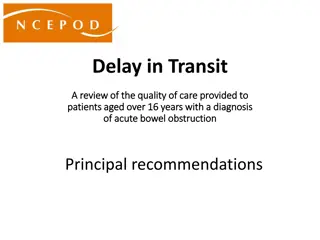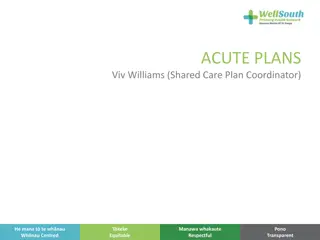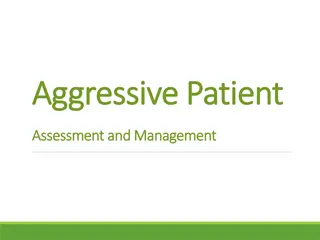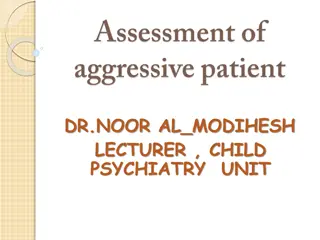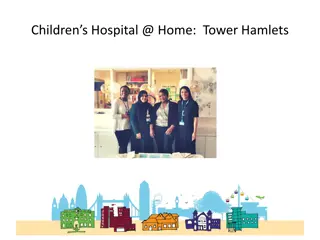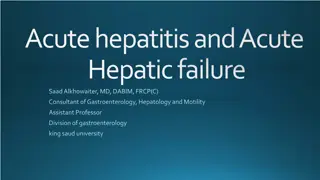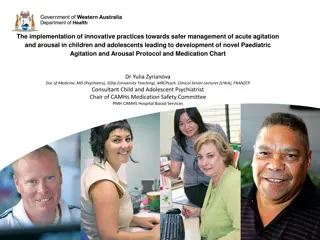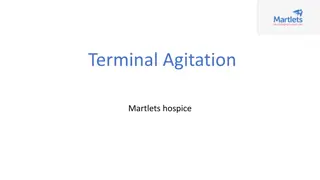The Medical Management of Acute Agitation
This article by Dr. R. Scott Babe provides insights into the medical management of acute agitation, catering to the educational curriculum for residents at Western University. It discusses important strategies, guidelines, and considerations for handling acute agitation in clinical settings, with a focus on psychiatric care. The content aims to enhance understanding and proficiency in managing agitated patients efficiently and effectively.
Download Presentation

Please find below an Image/Link to download the presentation.
The content on the website is provided AS IS for your information and personal use only. It may not be sold, licensed, or shared on other websites without obtaining consent from the author.If you encounter any issues during the download, it is possible that the publisher has removed the file from their server.
You are allowed to download the files provided on this website for personal or commercial use, subject to the condition that they are used lawfully. All files are the property of their respective owners.
The content on the website is provided AS IS for your information and personal use only. It may not be sold, licensed, or shared on other websites without obtaining consent from the author.
E N D
Presentation Transcript
The Medical Management of Acute Agitation APM Resident Education Curriculum R. Scott Babe, M.D. Clinical Assistant Professor of Psychiatry Western University of Health Sciences Samaritan Mental Health Corvallis, Oregon Thomas W. Heinrich, M.D. Associate Professor of Psychiatry & Family Medicine Chief, Psychiatric Consult Service at Froedtert Hospital Department of Psychiatry & Behavioral Medicine Medical College of Wisconsin Updated Fall 2013: Paula Zimbrean, M.D. Karina Uldall M.D., M.P.H. ACADEMY OF PSYCHOSOMATIC MEDICINE Psychiatrists Providing Collaborative Care for Physical and Mental Health
Objectives Identify the principles of the cycle of violence. Describe the broad differential diagnosis behind the symptoms of agitation and aggression. Apply nonpharmacologic and pharmacologic approaches to management of the agitated patient in the general medical setting. 2 Academy Of Psychosomatic Medicine
The Case A 47 year-old male with a history of substance abuse and bipolar disorder along with morbid obesity, DM and COPD presents to the ED at 0200 after calling 911 and reporting chest pain. Initially cooperative in the ED, but the staff indicate that he has been mumbling to himself and starring at them suspiciously. They gave him some lorazepam to calm him. Since arrival to the floor to r/o MI he has been becoming increasingly irritable, confrontational and restless. Eventually he starts to become uncooperative with care and then verbally and physically threatening to the staff. They call a psychiatry consult for HELP!!!! 3 Academy Of Psychosomatic Medicine
Definitions Agitation Excessive motor or verbal activity Aggression Actual noxious behavior that can be verbal, physical against objects, or physical against people Violence Denotes physical aggression by people against other people (Citrome and Volavka, 2002) 4 Academy Of Psychosomatic Medicine
Component Behaviors Aggressive behaviors Physical Fighting Throwing things Grabbing objects Destroying items Verbal Cursing Screaming Nonaggressive behaviors Restlessness (akathisia, restlessness) Wandering Inappropriate behavior (disrobing, intrusive, repetitive questioning) 5 Academy Of Psychosomatic Medicine
6 Academy Of Psychosomatic Medicine
Epidemiology There is little direct data on the prevalence, clinical impact, or financial consequences of agitation Behavioral emergencies responsible for 6% of all ED visits (Larkin et al 2005) Marco and Vaughn (2005) 4.3 million psychiatric emergency visits/year 21% (900,000) agitated patients with schizophrenia 13% (560,000) agitated patients with bipolar 5% (210,000) agitated patients with dementia 7 Academy Of Psychosomatic Medicine
Epidemiology Studies for health care workers California: 465 assaults per 100,000 hospital workers vs. 82.5 assaults per 100,000 for all workers (Peek-Asa et al 1997) Minnesota Nurses Study (Gerberich et al 2004): 13.2 per 100 persons per year for physical assaults 38.8 per 100 persons per year for non-physical assaults Greatest risk for persons working in/with: Long term care facility Intensive care Psychiatric unit Emergency department Geriatric patients 8 Academy Of Psychosomatic Medicine
Etiology of Agitation A. Disease-related: three major categories Psychiatric manifestations of general medical conditions Substance intoxication/withdrawal Primary psychiatric illness B. No disorder ; unlikely to benefit from medical intervention (e.g., criminal behavior) consider calling security or the police, depending on the severity Not mutually exclusive 9 Academy Of Psychosomatic Medicine
Etiology of Agitation: A Sample of the Varied Conditions that may Present with Pathologic Agitation Dementia Huntington's disease Brain injury Organic brain syndrome (delirium) Korsakoff s psychosis Brain tumors Mental retardation Autism Seizure disorder Major depression Dysthymia Bipolar disorder Substance intoxication or withdrawal Psychosis Premenstrual dysphoric disorder PTSD Panic disorder and GAD Antisocial personality disorder Borderline personality disorder ADD 10 Academy Of Psychosomatic Medicine
Etiology of Agitation: Medical Causes Head trauma Encephalitis, meningitis, other infection Encephalopathy, liver or renal failure Environmental toxins Metabolic abnormalities (sodium, calcium, glucose) Hypoxia Thyroid disease Seizures Toxic levels of medications (Nordstrom et al. Medical Evaluation and Triage of the Agitated Patient. Western J Emergency Med 2012; 1:3- 10.) 11 Academy Of Psychosomatic Medicine
Etiology of Agitation: Medical condition Delirium Disturbance of consciousness A change in cognition or development of perceptual disturbance Not accounted for by a dementia Disturbance develops over a short period of time and tends to fluctuate Caused by a general medical condition 12 Academy Of Psychosomatic Medicine
Etiology of Agitation: Substances Substance intoxication (ETOH, cocaine, amphetamines, ketamine, bath salts, inhalants) Substance withdrawal (ETOH withdrawal delirium/DTs) CNS effects of non-psychiatric medications (steroids) 13 Academy Of Psychosomatic Medicine
Etiology of Agitation: Primary Psychiatric disorders Schizophrenia Bipolar Dementia Personality Disorders 14 Academy Of Psychosomatic Medicine
Etiology of Agitation: Schizophrenia Acutely, patients may present to the ED with acute psychosis Hallucinations Delusions Disorganized speech and/or behavior Lack of insight Bizarre behavior Fertile conditions for the development of agitation Psychosis and agitation have a reciprocal relationship 15 Academy Of Psychosomatic Medicine
Etiology of Agitation: Schizophrenia Patients at highest risk for violence More suspicious and hostile More severe hallucinations Less insight into delusions Greater thought disorder Poor impulse control Risk factors for becoming a target Parent or immediate family member Cohabitation Patient financially dependent on you 16 Academy Of Psychosomatic Medicine
Etiology of Agitation: Personality Disorders Some personality disorders are more prone to agitation Decreased stress tolerance Poor impulse control Borderline personality disorder Antisocial personality disorder 17 Academy Of Psychosomatic Medicine
Etiology of Agitation: Dementia Overall, the incidence of agitation is estimated to be between 60-80% (median 44%) (Bartels et al 2003) 50% become frankly physically aggressive 24% become verbally aggressive Burden of institutionalization Residents with dementia complicated by agitation have the highest 3-month rate of ED visits and greatest use of restraints (Sachs, 2006) Despite use of restraints, over 40% receive no psychiatric medications 18 Academy Of Psychosomatic Medicine
Etiology of Agitation: Dementia Agitation may be a final common pathway for the expression of Depression Anxiety Psychosis Pain Delirium While agitation may be of multifactorial etiology in patients with dementia, it is also true that many patients have only agitation as a target symptom for treatment (Madhusoodanan, 2001) 19 Academy Of Psychosomatic Medicine
Etiology of Agitation Psychodynamic perspectives of agitation and violence motive or cause of violent behavior is the wish to ward off or eliminate feelings of shame and humiliation [ego integrity] (Hodas, 2004) Crisis can be defined as an assault on the person s sense of self (Bernstein, 2007) Violence is often in response to blocking of demands or loss of control (Bernstein, 2007) A psychological understanding of aggressive behavior can help temper counter-transference 20 Academy Of Psychosomatic Medicine
The Case (continued) Potential etiologies for our gentleman s growing agitation Substance intoxication Bipolar disorder Personality disorder Delirium 21 Academy Of Psychosomatic Medicine
Assessment of Agitation Decisions regarding diagnostic tests must be made in the context of available history and physical examination Goal is to evaluate patients at risk for medical comorbidities Many questions involve forced decisions based on Assumptions Information available Diagnostic confidence Patient s individual risk factors 22 Academy Of Psychosomatic Medicine
Assessment of Agitation For a known schizophrenic with typical behavioral features Expectant management is appropriate For patients with atypical features additional diagnostic tests may be required Atypical presentations Delirium History of trauma Overdose Headache Fever Diagnostic tests to consider Toxicology screens CT of brain BMP, CBC, and LFTs Urinalysis Endocrine tests Lumbar puncture 23 Academy Of Psychosomatic Medicine
The Case (continued) Examination of the patient The patient is febrile with normal vitals Malnourished, disheveled, and stinky Heart, lungs and abdomen are benign No tremor or asterixis Mental status/state examination reveals 24 Academy Of Psychosomatic Medicine
The Case (continued) Laboratory evaluation of the patient CBC, BMP are normal except for a glucose of 211 LFTs are normal except for a low albumin TSH, B12, Folate, and RPR are also normal U/A is positive for glucose and trace CT of head is read as negative EKG shows QTc < 400msec UDS and serum toxicology are negative VPA, carbamazepine, and lithium are all negative 25 Academy Of Psychosomatic Medicine
Before the Acute Intervention The staff on Med/Surg units are often less informed about what feelings and behaviors their actions may elicit in patients Studies indicate that staff training and education can change this lack of appreciation Psychiatric consultants should provide education about Establishing goals from the patients perspective Interventions that support a structured setting Private or semi-private room Establish clear set of expectations with a written schedule Identify staff that are responsible for the patients care Attempting to enlist the patient in the treatment, i.e. which route of medication has worked the best in the past as a choice which retains some patient control 26 Academy Of Psychosomatic Medicine
Goals of Intervention Acute agitation or a violent patient modifies the normal caregiver-patient relationship The first goal of treatment is to do only what is necessary to assure the safety of the patient and others while facilitating the resumption of more normal interpersonal relations Calming without over-sedation 27 Academy Of Psychosomatic Medicine
Agitation Management Medical evaluation and triage Psychiatric evaluation Verbal de-escalation Psychopharmacologic interventions Use of seclusion/restraint (Project BETA: Best practices in Evaluation and Treatment of Agitation, Western J Emergency Med 2012; 1:1-2) 28 Academy Of Psychosomatic Medicine
Environmental Interventions Examples of effective non-pharmacological treatments Clearing the room Removing dangerous objects Having staff available as a show of force Close observation Calm conversation Decrease sensorial stimulation 29 Academy Of Psychosomatic Medicine
Communication/Behavioral Interventions Nonverbal Maintain a safe distance Maintain a neutral posture Do not stare; eye contact should convey sincerity Do not touch the patient Stay at the same height as the patient Avoid sudden movements Verbal Speak in calm, clear tone Personalize yourself Avoid confrontation; offer to solve the problem (APA Textbook of Psychosomatic Medicine, 2nd ed. Edited by James L. Levenson. 2011) 30 Academy Of Psychosomatic Medicine
Communication/Behavioral Interventions Aligning Goals of Care Acknowledge the patient s grievance Acknowledge the patient s frustration Shift the focus to discussion of how to solve the problem Emphasize common ground Focus on the big picture Find ways to make small concessions Monitoring Intervention Progress Be acutely aware of progress Know when to disengage Do not insist on having the last word (APA Textbook of Psychosomatic Medicine, 2nd ed. Edited by James L. Levenson. 2011) 31 Academy Of Psychosomatic Medicine
The Case (continued) You and the nursing staff Clear the room Keep dangerous objects out of reach Call security You attempt to approach the patient using everything you learned in this amazing talk Despite these great interventions the patient makes further threats, rips-off telemetry lines, and starts to pace with clenched fists while mumbling incoherently 32 Academy Of Psychosomatic Medicine
A little bit of history 33 Academy Of Psychosomatic Medicine
Serotonin-Dopamine Model of Regulation of Agitation Dynamic interaction between the amygdala, nucleus accumbens, and the prefrontal cortex Amygdala activation Serotonin Nucleus Accumben s Suppression Dopamine Released Prefrontal Cortex agitation (Ryding et al, 2008) Provides a basis for the response to certain medications 34 Academy Of Psychosomatic Medicine
Goals of Intervention Definition of psychopharmacologic treatment endpoint (rapid tranquilization) Sleep Conflicts with goal of patient participation Has not been found to be essential to improvement in agitation or decrease in psychotic symptoms Tranquillization Calming process separate from total sleep induction Allows patient to participate in care Enables clinician to gather history, initiate a work-up, and begin treatment of unidentified conditions Better therapeutic endpoint 35 Academy Of Psychosomatic Medicine
Pharmacologic Considerations Ease of preparation/administration Rapid onset of action: IV > IM > PO Sufficient duration of effect Low risk of adverse reactions or drug interactions What is known about the patient s underlying condition(s)? Age Comorbid conditions Medication/other substance exposure (Zeller et al, Systematic Reviews of Assessment Measures and Pharmacologic Treatments for Agitation. Clin Therapeutics 2010; 32:405-425) 36 Academy Of Psychosomatic Medicine
Pharmacologic Treatment Most important factors in medication selection (Marder, 2006, Allen et al, 2005) Etiology of agitation Acute effect on behavioral symptoms Multiple means of administration Limited side effects Ease of administration Patient preference History of response Goal is a balance between effectiveness and tolerability 37 Academy Of Psychosomatic Medicine
Pharmacologic Treatment Route of administration Oral administration Preferred if patient accepts Liquid or orally dissolving tablets Intramuscular administration Rapid elevation of plasma level Higher transient concentration Faster reduction in agitated behavior 38 Academy Of Psychosomatic Medicine
Pharmacologic Treatment Most studies of pharmacologic treatment in agitation were done in patient with KNOWN psychiatric diagnosis No randomized, controlled studies have examined the use of medications in populations with Severe agitation Drug-induced agitation Significant medical comorbidity Results difficult to extrapolate to the undifferentiated agitated patient in the general ED or med/surg unit 39 Academy Of Psychosomatic Medicine
Association for Emergency Psychiatry Recommendations . No Data/Suspect Intoxication benzodiazepines or benzodiazepines + haloperidol Schizophrenia or Mania olanzapine alone orally risperidone alone or + benzodiazepine orally haloperidol +benzodiazepine orally olanzapine alone if IM required (Allen MH et al, for the Expert Consensus Panel for Behavioral Emergencies 2005. The expert consensus guideline series. Treatment of behavioral emergencies 2005. J Psychiatr Pract. 2005;11(Suppl 1):5 108) 40 Academy Of Psychosomatic Medicine
Benzodiazepines BZDs act by facilitating the activity of GABA GABA is a major inhibitory neurotransmitter Therapeutic effects appears linked to decreased arousal Little benefit for psychiatric symptoms other than anxiety Long history of use in the management of acute agitation Individually Combination with antipsychotics Preferred in a patient in whom agitation is secondary to alcohol or sedative withdrawal 41 Academy Of Psychosomatic Medicine
Benzodiazepines Lorazepam Only BZD with complete and rapid IM absorption No involvement of P450 system IM or sublingual administration 60-90 minutes until peak plasma concentration 8-10 hour duration of effect 12-15 hour elimination half-life Studies suggest that lorazepam 2mg is at least as effective as haloperidol in controlling acute agitation 42 Academy Of Psychosomatic Medicine
Benzodiazepines Side effects Excessive sedation Additive with other CNS depressants Respiratory depression BZDs avoided in patients at risk for CO2 retention Paradoxical disinhibition More likely with high doses in patients with structure brain damage, mental retardation or dementia Ataxia 43 Academy Of Psychosomatic Medicine
Typical Antipsychotics Dopamine antagonist Positive Antipsychotic Antiagitation Negative Extrapyramidal symptoms (EPS) Neuroleptic Malignant Syndrome (NMS) Many authors consider typical antipsychotics the treatment of choice in acute agitation 44 Academy Of Psychosomatic Medicine
TypicalAntipsychotics Low potency Not recommended High potency - haloperidol Virtually no anticholinergic properties Little risk of hypotension Does not suppress respiration Can be given IV Not FDA approved Little cardiotoxicity Concern of QTc prolongation Fast acting Onset of action: 30 minutes Duration of action up to 12-24 hours (Powney MJ. Adams CE. Jones H. Haloperidol for psychosis- induced aggression or agitation (rapid tranquillisation). [Review] Cochrane Database of Systematic Reviews. 11:CD009377, 2012) 45 Academy Of Psychosomatic Medicine
TypicalAntipsychotics Side effects Extrapyramidal symptoms Dystonia Akathisia Parkinson-like effects QTc prolongation Rare at low doses Haloperidol and droperidol with Black Box warnings Lower seizure threshold Low-potency > high-potency antipsychotics 46 Academy Of Psychosomatic Medicine
Typical Antipsychotics: Loxapine Inhaled Loxapine has been recently endorsed by FDA for treatment for agitation in Bipolar I disorder Need to monitor for bronchospasm, especially in patients with asthma (Owen RT. Inhaled loxapine: a new treatment for agitation in schizophrenia or bipolar disorder. Drugs of Today. 49(3):195-201, 2013 Mar) 47 Academy Of Psychosomatic Medicine
Atypical Antipsychotics Major advance in psychiatry Broader spectrum of response Different side effect profile Less EPS and akathisia QTc concern remains Metabolic syndrome No randomized, controlled studies have examined the use of medications in populations with Severe agitation Drug-induced agitation Significant medical comorbidity 48 Academy Of Psychosomatic Medicine
Atypical Antipsychotics Risperidone Oral solution Oral tablet Oral tablet, disintegrating Olanzapine Intramuscular Oral tablet Oral tablet, disintegrating Quetiapine Oral tablet Ziprasidone Intramuscular Oral tablet Aripiprazole Intramuscular Oral solution Oral tablet Oral tablet, disintegrating 49 Academy Of Psychosomatic Medicine
Atypical Antipsychotics Risperidone (Currier and Simpson 2001, Currier et al 2004) 2 studies have compared have compared Oral risperidone concentrate 2mg + oral lorazepam 2mg IM haloperidol 5mg + IM lorazepam 2mg The two interventions were equally effective at reducing agitation at 30, 60, and 120 minutes So In agitated patients willing to take oral medication and comply with treatment, the combination of oral risperidone and lorazepam appears to be acceptable 50 Academy Of Psychosomatic Medicine
